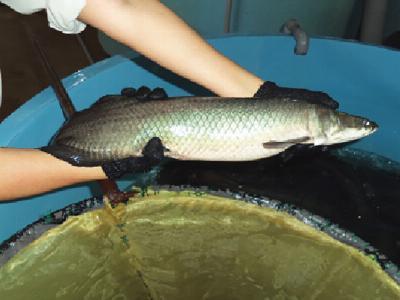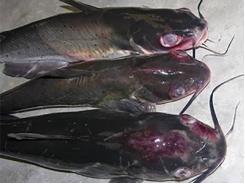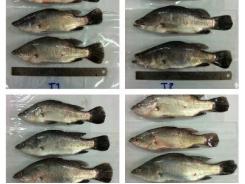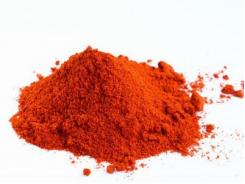Soy-based feeds evaluated for production of Amazonian paiche

Fast-growing species produced via aquaculture since 2009
The feeding demonstration at Amazon Fish Products S.A. evaluated the performance of paiche given three different feeds. Interest in growing paiche relates to the fact the fish can grow up to 15 kg/year in culture.
Arapaima, pirarucu or pacha (Arapaima gigas) is the largest freshwater fish. Growing up to 3 meters in length and 200 kg in weight, they are endemic to tropical South America and are found primarily in the lowlands of the watersheds of the Araguaia-Tocantins, the Solimões-Amazon River, and Essequibo River basins in Brazil, Guyana and Peru.
Although the paiche has been included on the international trade-restricted list due to the fact that it is considered endangered by the Convention on International Trade in Endangered Species, the company Amazon Fish Products S.A. has a permit to commercialize the fish because they have been produced by aquaculture since 2009. The interest in growing paiche is related to the fact that the fish have the best growth rate among Amazonian cultivated fish species, growing 27-41 g/day and up to 15 kg/year.
Paiche diets
Paiche feed on prey consisting primarily of detritivorous/algivorous and omnivorous fish that are not top predators, and probably play a key role in regulating the energy and nutrient flows of aquatic ecosystems. In aquaculture, the fish are fed high-protein (45 percent) feed, which can become a limiting factor for production due to the cost and availability of fishmeal ingredients.
The authors therefore performed a commercial feeding demonstration to evaluate the use of new soy ingredients that have high protein content and low levels of the oligosaccharides raffinose and stachyose as partial replacements for fishmeal in diets for paiche. The feeding demonstration was conducted at the Amazon Fish Products hatchery in Ucayali, Pucallpa, Peru.
Study setup
Three test diets formulated to contain 45 percent crude protein and 13 percent fat were assigned to two 0.85-cubic meter replicate tanks in sequential order, with a commercial diet (COM) in tanks C1 and C2, an experimental diet with low-oligosaccharide soybean meal (S.M.) in tanks C3 and C4, and an experimental diet with soy protein concentrate (SPC) in tanks C5 and C6. All tanks were operated with a constant water flow of 5 L/minute.
Fish for the demonstration had an average individual weight of 647.4 g. They were intended to be stocked at a density of 62 fish/tank, with an average fish biomass equivalent to 47.4 kg/cubic meter, but some of the fish jumped between tanks. The results of this demonstration should therefore be considered anecdotal.
The fish were fed ad libitum, and six fish were sampled weekly from each tank over a 62-day period. Individual fish weights and lengths were determined during each sampling. Fish were harvested after 62 days at an average weight of 2.0 kg.
Results
The weekly growth data is shown in Tables 1 and 2. Final average weights for fish fed the commercial diet were 2,198 and 2,132 g in each replicate tank, while average weights for fish fed the S.M. diet were 2,121 and 2,166 g. Average fish weights for the SPC treatment were 1,981 and 2,098 g.
Quintero, Table 1
| Treatment | Replicate | No.of fish: Initial | No.of fish: Final | Survival (%) | Individual weight (g) Initial | Individual weight (g) Final |
| COM | C1 | 61 | 61 | 100 | 674.44 | 2,197.7 |
| COM | C2 | 64 | 64 | 100 | 674.44 | 2,132.0 |
| S.M. | C3 | 53 | 52 | 98.1 | 674.44 | 2,120.8 |
| S.M. | C4 | 60 | 60 | 100 | 674.44 | 2,166.0 |
| SPC | C5 | 62 | 55 | 88.7 | 674.44 | 1,980.8 |
| SPC | C6 | 75 | 74 | 98.7 | 674.44 | 2,097.8 |
Production data collected after a 62-day feeding demonstration with paiche
Relative weight, a measure of fish condition, indicates if animals are thin or fat. A fish with a relative weight value of 80 percent or less is considered severely thin, indicating a lack of food. Fish for this demonstration were in very poor condition at the time of stocking, with relative weights of 78.59 ± 4.09 percent. After the first sampling, fish condition improved to an average of 94.57 percent, and by the end of the demonstration, the average relative weight for all the fish was 99.07 percent.
Fish biomasses at harvest were 158.3 and 161.1 kg/cubic meter for the two tanks fed the commercial diet. Fish in tanks fed the soybean meal-based diet had harvest biomasses of 130.2 and 153.4 kg/cubic meter, while fish fed the SPC diet had biomasses of 128.6 and 180.8 kg/cubic meter (Table 2, Figure 1).
Quintero, Table 2
| Treatment | Replicate | Weight gain | Specific growth rate | Blomass gained (kg) | Final density (kg/m3) | Feed Conversation Ratio |
| COM | C1 | 239.43 | 1.97 | 94.56 | 158.27 | 0.92 |
| COM | C2 | 229.30 | 1.92 | 95.01 | 161.10 | 0.87 |
| S.M. | C3 | 227.57 | 1.91 | 75.97 | 130.20 | 0.99 |
| S.M. | C4 | 234.55 | 1.95 | 91.11 | 153.44 | 0.92 |
| SPC | C5 | 205.94 | 1.80 | 68.80 | 128.62 | 1.18 |
| SPC | C6 | 224.01 | 1.90 | 106.68 | 183.28 | 0.94 |
Production data collected after a 62-day feeding demonstration with pacha
With a value of 234.4 percent, average weight gain was highest for paiche given the commercial diet. Fish that received the S.M. feed had weight gains of 231.1 percent, and paiche on the SPC diet gained 215.0 percent.
Feed-conversion ratios (FCRs) were lower for fish fed the COM diet, with an average ratio of 0.895 ± 0.035. Fish fed diet S.M. had an average FCR of 0.950 ± 0.057, and fish fed the SPC diet had an average FCR of 1.060 ± 0.170.

Figure 1. Average culture density for paiche given three test feeds.
Perspectives
The results of this study confirmed that paiche can be raised at very high densities. Diets based on soybean meal and feed-grade soy protein concentrate yielded fish performance similar to that for paiche fed a fishmeal-based diet. Hence, soy-based feeds can be alternatives to traditional fishmeal-based feeds for the continued development of a commercial paiche-farming industry.
Herbert E. Quintero, Ph.D.
- Aquaculture Research Station
- University of Arkansas at Pine Bluff
- 1200 North University Drive
- Mail Slot 4912
- Pine Bluff, AR 71601 USA
Michael C. Cremer, Ph.D.; Jairo Amezquita; Francisco de la Torre
- U. S. Soybean Export Council
- Guadalajara World Trade Center
- Guadalajara, Jalisco, Mexico
Luis Henostroza
- Amazon Fish Products,
- S.A., Kilometro 10
- de la Carretera Federico Basadre
- Pucallpa, Ucayali, Peru
Related news
Tools

Phối trộn thức ăn chăn nuôi

Pha dung dịch thủy canh

Định mức cho tôm ăn

Phối trộn phân bón NPK

Xác định tỷ lệ tôm sống

Chuyển đổi đơn vị phân bón

Xác định công suất sục khí

Chuyển đổi đơn vị tôm

Tính diện tích nhà kính

Tính thể tích ao




 Pirarucu culture in the Brazilian Amazon
Pirarucu culture in the Brazilian Amazon  The importance of carotenoids in aquafeeds
The importance of carotenoids in aquafeeds